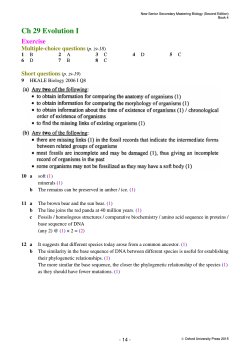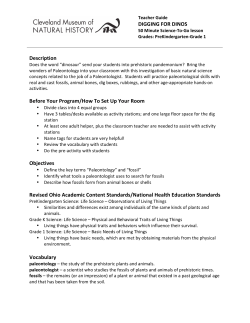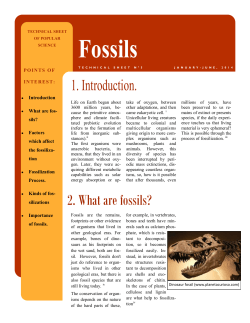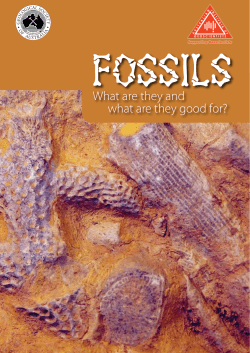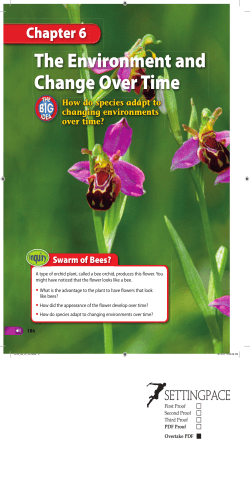
There are many treasures beneath our Indiana soil that are... LESSON PLAN FOR MAKE A FOSSIL
LESSON PLAN FOR MAKE A FOSSIL Episode Five 305 – Underground Indiana (Earth Science) There are many treasures beneath our Indiana soil that are world famous – including some amazing fossils of fern plants and crinoids from ancient seas. From artifacts to fossils and limestone, underground Indiana is an amazing place. One of best buried treasures just might be the imprint of a fern leaf fossil that was left over when Indiana was covered in ancient forests. In this episode we explore the science of what might be found in Underground Indiana. Funded by: Eli Lilly and Company Foundation Dr. Laura Hare Charitable Trust Indiana Academy of Science Overview Students will gain an understanding of how fossils are formed and what can be learned from them. Children love fossils because they are evidence that strange, fantastic worlds can exist. Imagination and reality come face to face when a child holds a fossil in their hand. What did it eat? How did it move? Was it real? What does its name mean? How long ago did it live? It is these questions that make children and scientists alike want to find out more. The best reason for studying fossils is to provide students, teachers and parents a unique opportunity to use science to answer questions and solve problems. Science can be used to make observations, collect data, test ideas and draw conclusions about the ancient Indiana fossils. Background information Fossils are clues to the past. They are nature’s records written in rock. A fossil is the remains, imprint or trace of an organism preserved in the earth’s crust. To some people fossils are just curious natural oddities of little value. To scientists, fossils are a window into past geologic ages — the physical evidence and data used to test hypotheses and build theories that lead to better understanding of ancient life. When children hold fossils their imagination instantly transports them to a world where dinosaurs walked the earth. Fossils are powerful learning tools that motivate children to “read” the clues they offer about prehistoric plants and animals. How do fossils form? Only a small number of living plants and animals become fossils. Most dead plants and animals are eaten by other animals. Some, however, are shrouded in mud or sand. Those covered over many millions of years ago hardened and turned to stone. More recently, wind, water and sun have slowly eroded the rock, exposing the hidden fossilized remains. Specific conditions are required for fossils to form. Plants and animals in areas of mud, sand, ash or other sediments are most likely to become fossilized. Once the plant or animal is buried and the sediment has hardened, other factors play important roles in fossil formation — oxygen, sunlight, microorganisms, permineralization and other geologic forces. Even with millions of years to form, a fossil is still the result of a rare and unique process. Where do you find fossils? Fossils can be found the world over, but some of the best fossils are found in dry climates where the land has eroded to expose sedimentary rock. Paleontologists are scientists who study fossils and ancient life. Connections to the Indiana Academic Core Standards for Science, Grades 3 – 7 The following standards contain the grade-level standards and indicators addressed in this lesson. 2.1.3, 2.2.5, 2.3.1, 2.3.5, 2.4.4, 2.5.6, 2.6.3 Science Process Skills • Calculating • Communicating • Hypothesizing and predicting • Inferring • Measuring • Posing questions Estimated Time Requirement One 45- minute session Materials • Plastic drop cloth (open up a large trash bag) • Paper towels • Pam or light cooking oil For each student: • Model clay – large piece • Object: sea shells, leaves, coins, various objects • One cup of Plaster of Paris, or dental plaster • Plastic cups – two • Water – 2/3 cup • Craft stick stirrer Vocabulary Fossil — Latin for “dug up,” it is evidence of past life, the remains or traces of plants and animals that have turned to stone or rock. Adaptation — a body part or behavior that produces an advantage for the animal. This could be feathers, fur, scales, teeth or beaks, or migration and hibernation. Model — a representation that is both like and different from the real thing. Objectives Students will be able to: Students learn what a fossil is, observe and examine fossils, and make their own drawings, casts and models. Focus Questions How does a fossil form? Can fossils be made today? Are all fossils the same? What can be learned by comparing fossils? What are the different types of fossils? What are some conditions needed for fossils to form? Procedure Anticipatory set: • Visit the website: www.IndianaExpeditions.org • View the Underground Indiana Indiana Expeditions segment • View the Earth Science Indiana Expeditions segment from season 1. • View the video lesson from the this episode Lesson sequence: • Prepare the materials prior to the start of class. o Spread drop cloth or plastic o Measure out one cup of plaster for each student o Place a craft stick in the dry plaster o Pre-oil the objects that will be used with light cooking oil o Measure out a large lump of modeling clay for each student. Warming the clay under a heat lamp or in the microwave (set low) will make the clay easier to work with. Cold clay is hard clay. o Prepare a large container of water. Have a measuring cup ready to dispense 2/3 cup of water to each student. Having another set of cups with the premeasured water is a big help. o Option - Mix up enough plaster of paris for the entire class in one large container. Quickly go around the room and pour out the plaster into each clay impression. The consistency should be like a thick milk shake – not too runny and not like peanut butter. • Inform the students that today they are all going to investigate how fossils are formed. • Students will enjoy and find better understanding of what a fossil is by viewing the Reading Rainbow video Digging Up Dinosaurs or read aloud the book by Aliki. • Discuss with the class how a dinosaur fossil forms. • Use the Internet or books to learn more about how a fossil is formed. • Describe each step and write or draw a picture on chart paper. Emphasize that several conditions must occur for a fossil to form. • Share with the class that complete fossils are rare. Most plants and animals in the world end up inside another animal as food. Make the connections between fossils and sediments and sedimentary rocks — fossils form when sediments cover the original organism. • Review how a fossil forms with the class. (see diagram at end of this lesson) • Pass out clay to the group. Roll out the clay. Each student should make impressions with a shell, leaf, or other natural or manmade object. The object should be pre-oiled. • Use one of the objects to make impressions in the clay. This is a model of how animals make tracks in mud. • Tell the students that their impression is like a fossil mold. All that is needed is for mud or other materials to fill in the impression or mold and a cast will be made. • Tell the class that you will simulate or model what might have happened long ago when a fossil mold or cast was formed. • Ask students to mix their water and plaster. Stir with their craft stick. This is time sensitive. It should be the consistency of a thick milk shake. It if is lumpy – it might be saved with more water. • • • Option - Pour wet plaster into each clay impression or mold. Once the plaster has been added gently shake the materials to allow bubbles to come to the top. Students should notice that the plaster will start to heat up. This is an exothermic chemical reaction. This means – it gets hot as a new substance (hard plaster) is formed. Allow the plaster to dry overnight before removing it from the clay. Students will have created a cast of the clay mold. Closure: Ask them to draw pictures of their fossil casts and share with the group. Suggested Student Assessment Objectives: Ask students to write and/or illustrate what they did during this activity and what they learned from their participation in the activity. Extending the Lesson Have students visit the Children’s Museum of Indianapolis – Dinosphere or SciencePort to have hands on experience working with fossils. Resources: The Children’s Museum of Indianapolis Dinosphere – Now You Are In Their World http://www.childrensmuseum.org/themuseum/dinosphere/index.html Dinosphere – Unit of Study Grades K-2 http://www.childrensmuseum.org/teachers/unitsofstudy/dinosphere/dinosphere_uos_k-2.pdf Dinosphere – Unit of Study Grades 3-5 http://www.childrensmuseum.org/teachers/unitsofstudy/dinosphere/dinosphere_uos_3-5.pdf Dinosphere – Unit of Study Grades 6-8 http://www.childrensmuseum.org/teachers/unitsofstudy/dinosphere/dinosphere_uos_6-8.pdf Source of Lesson Adapted from lessons created for The Children’s Museum of Indianapolis Dinosphere Units of Study by Rick Crosslin To learn more, visit the website at www.IndianaExpeditions.org
© Copyright 2025
